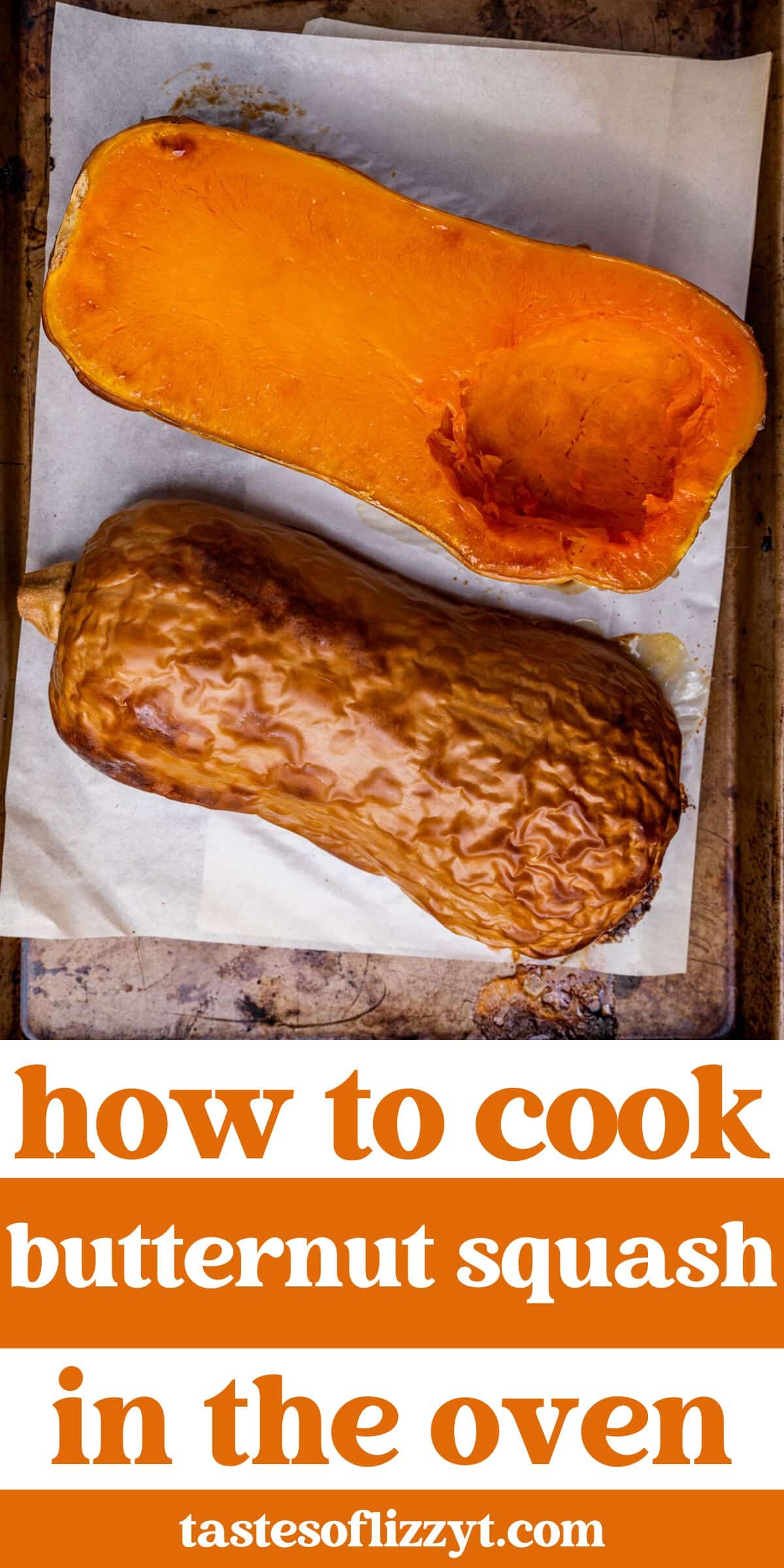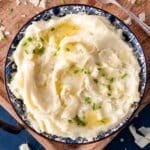How to Cook Butternut Squash in the Oven
May contain affiliate links. Disclosure policy.
Butternut squash is a delicious and nutritious fall and winter vegetable that is versatile and easy to cook. Here’s our step-by-step guide on how to cook butternut squash in the oven.
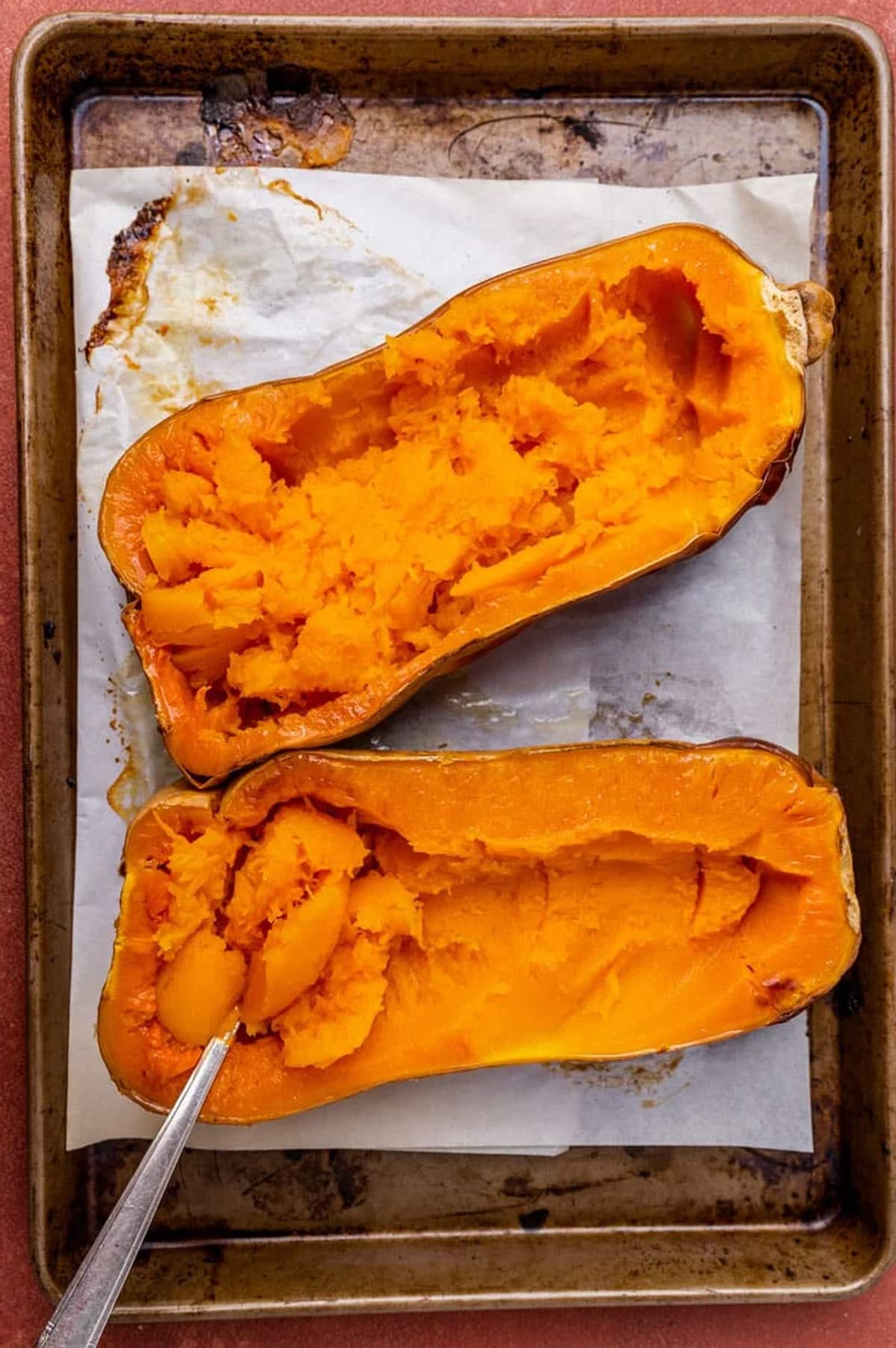
This is your ultimate guide on how to cook butternut squash in the oven. From selecting the right squash to the perfect seasoning, this recipe will show you step-by-step how to create a delicious and healthy side dish that is easy to prepare.
How to Pick a Butternut Squash
When choosing a butternut squash, there are a few key things to look for to ensure you select a ripe and tasty one:
- Size and shape: Butternut squash should be uniform in shape and relatively large, typically weighing around 1-2 pounds. Avoid squash that is smaller or oddly shaped, as these may be underdeveloped and less flavorful.
- Color: The skin of a ripe butternut squash should be smooth and a consistent, deep beige color. Avoid squash with green patches or any signs of decay.
- Weight: Choose a butternut squash that feels heavy for its size. It should not feel spongy or have soft spots
- Stem: A good butternut squash should have a firm, dry stem that is not withered or discolored.
- Dull Skin: The skin should be dull, not shiny. This means that the squash is fully ripe. Shiny skin means its under ripe
How to Peel Butternut Squash
There are a few different ways to peel a whole butternut squash, but the easiest and most effective method is to use a Y-shaped vegetable peeler. Here are the basic steps:
- Cut off the stem and bottom of the squash to create a stable base and an even surface to work on.
- Hold the squash firmly on a cutting board and use a vegetable peeler to peel off the skin in long, downward strokes, turning the squash as you go until all the skin has been removed.
- Once the skin has been removed, use a sharp knife to remove any remaining bits of skin or tough fibrous parts from the flesh.
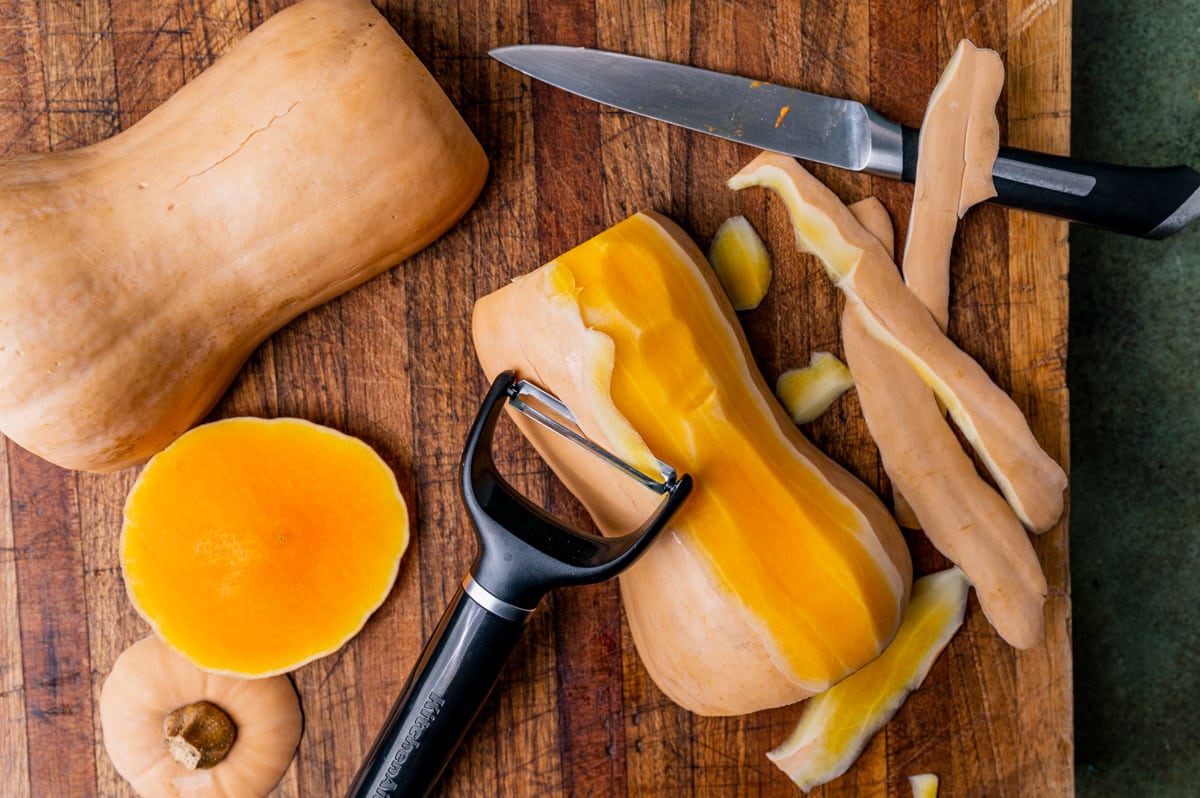
An alternative way to peel butternut squash is to first cook the squash a bit to soften the skin. This can be done by microwaving the whole squash for a few minutes or by roasting it in the oven for 15 minutes or so. After this, the skin will come off more easily using a vegetable peeler or a knife.
How to Cook Butternut Squash in the Oven
This recipe is for a roasted butternut squash that is cut in half and cooked in its skin.
- Preheat the oven to 400ºF. Line a baking pan with parchment paper.
- Cut the butternut squash in half lengthwise.
- Use a spoon to scoop out seeds. Throw away any seeds and pulp.
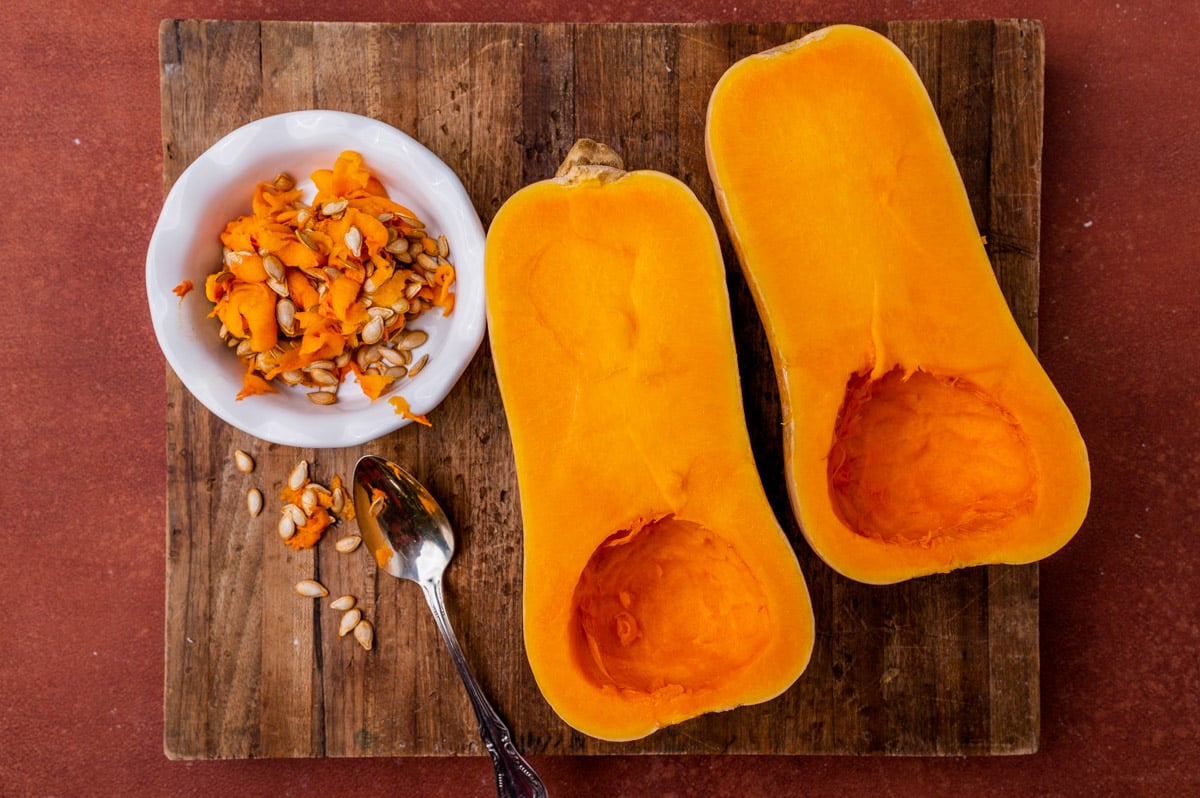
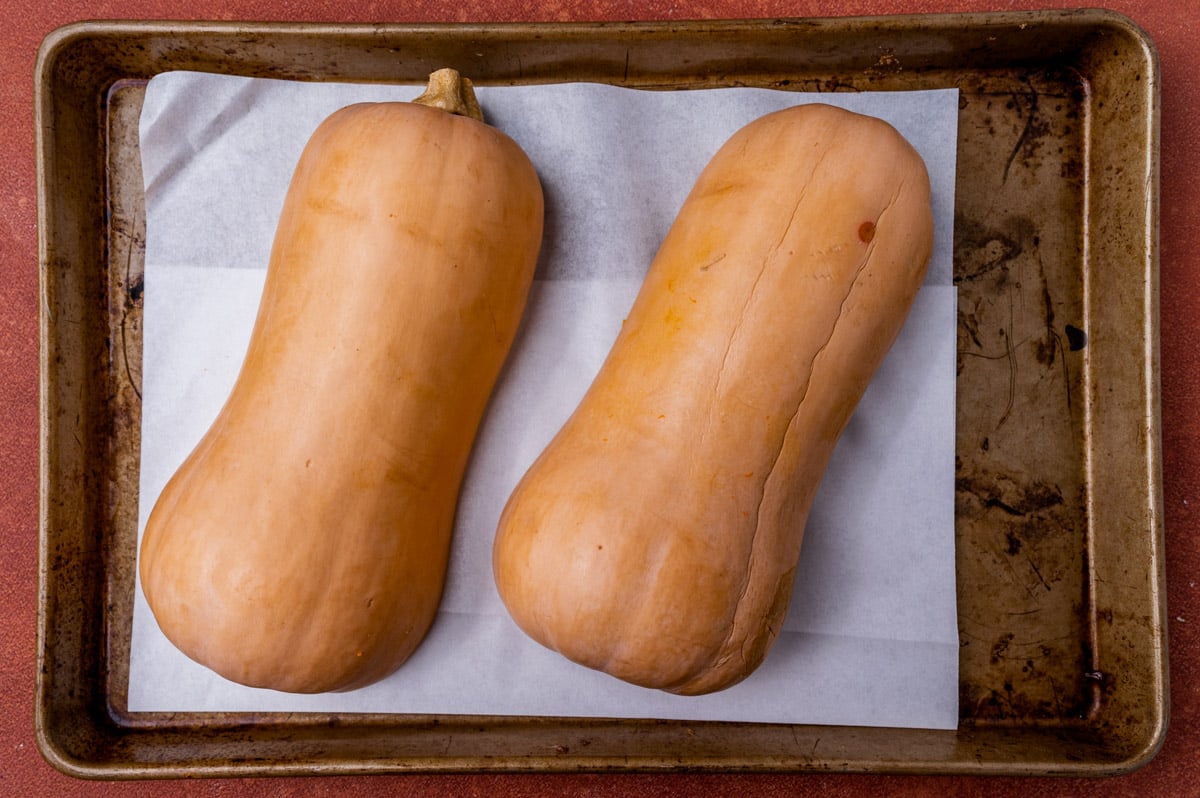
- Place the squash on the prepared pan, cut side down. Or, you can bake them cut side up, spreading with butter and sprinkling with salt and pepper before baking. There is no need to cover the squash with aluminum foil.
- Bake for 45-55 minutes. Test the thickest part of the squash to make sure it is done.
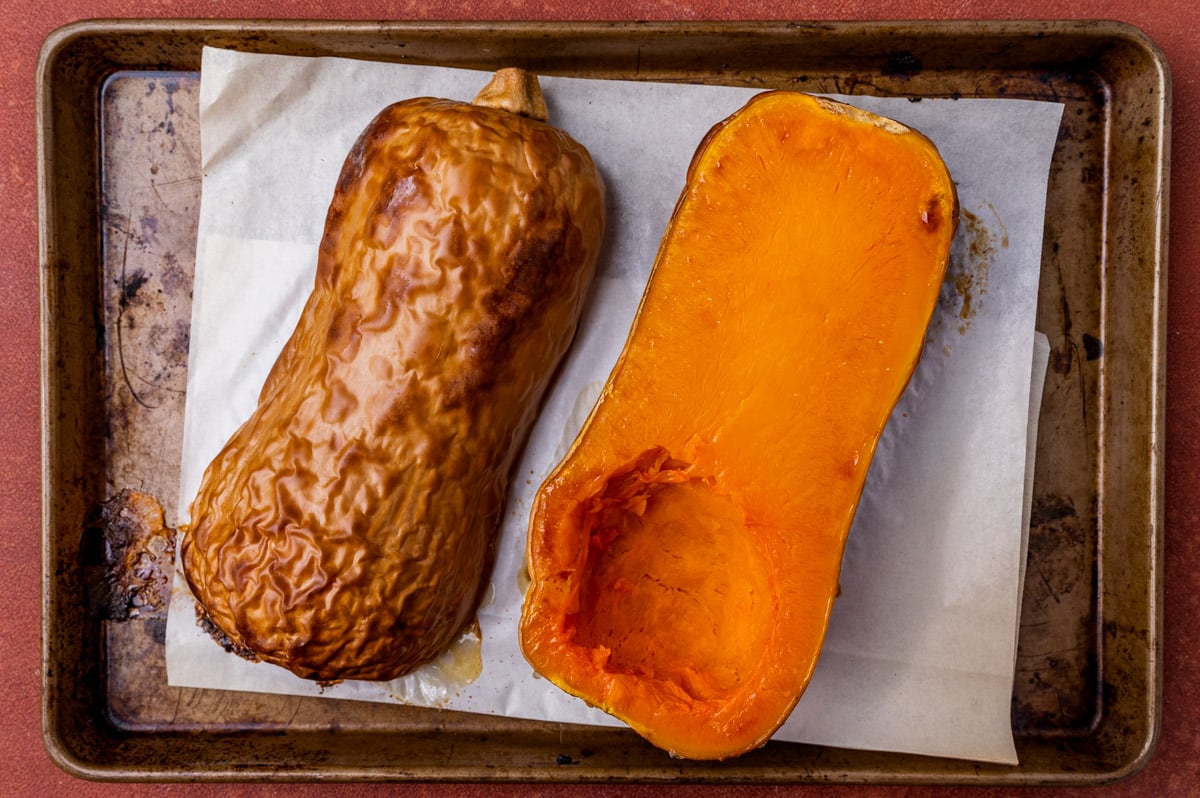
How to Roast Butternut Squash Cubes
If you’re looking for roasted butternut squash cubes, this is your recipe:
- Preheat your oven to 450°F.
- Cut the bottom and the stem off of the squash.
- Cut the butternut squash in half lengthwise, and scoop out the seeds and stringy pulp with a spoon. Discard the seeds and pulp.
- Peel the skin off the squash with a vegetable peeler or a sharp knife.
- Cut the squash into bite-sized 1-inch cubes.
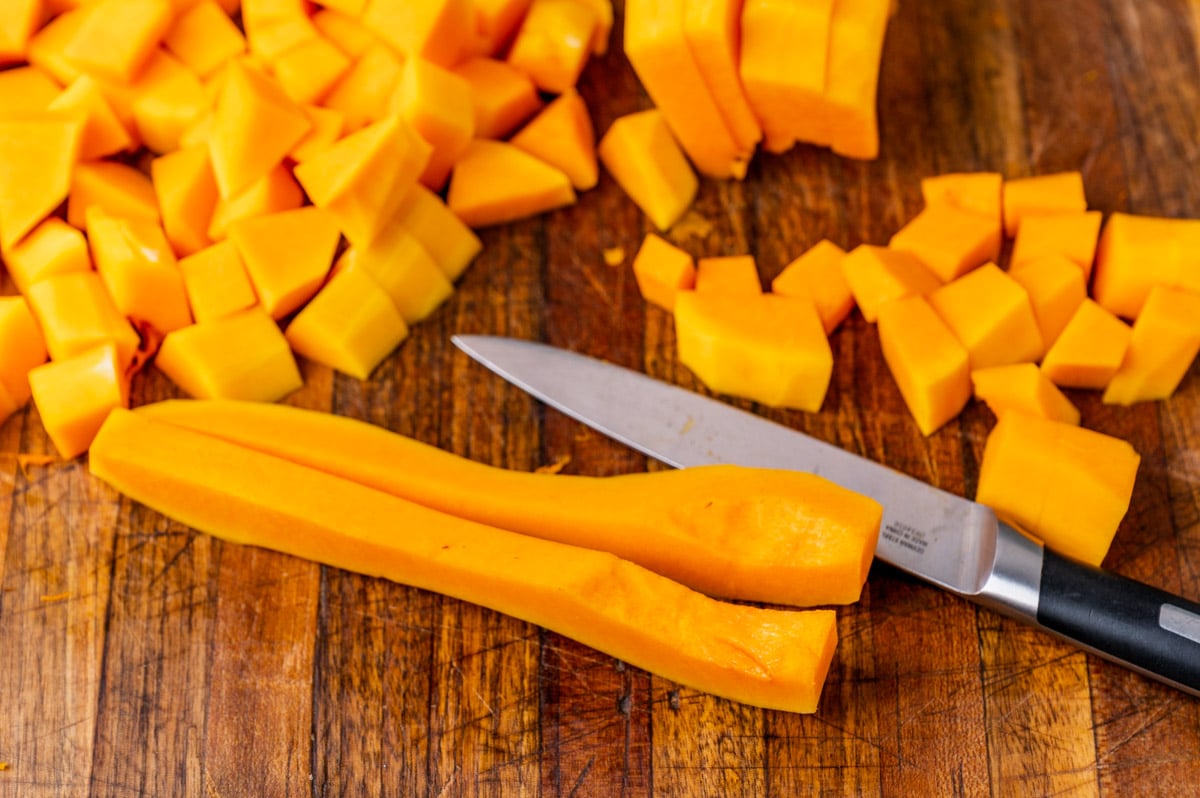
- Toss the cubed squash with 1-2 tablespoons of olive oil, and season with salt and pepper to taste.
- Spread the squash out in a single layer on a greased baking sheet. (Dark baking sheets will help the squash brown more quickly.)
- Roast the squash in the preheated oven for 10 minutes, then stir. Roast for another 5 minutes and stir again. Then turn the oven to broil on low. Continue to cook the squash under the broiler, stirring every 2-3 minutes. This will help ensure it doesn’t brown. If you don’t care about it being crispy brown, just allow it to continue cooking at 450ºF instead of under the broiler.
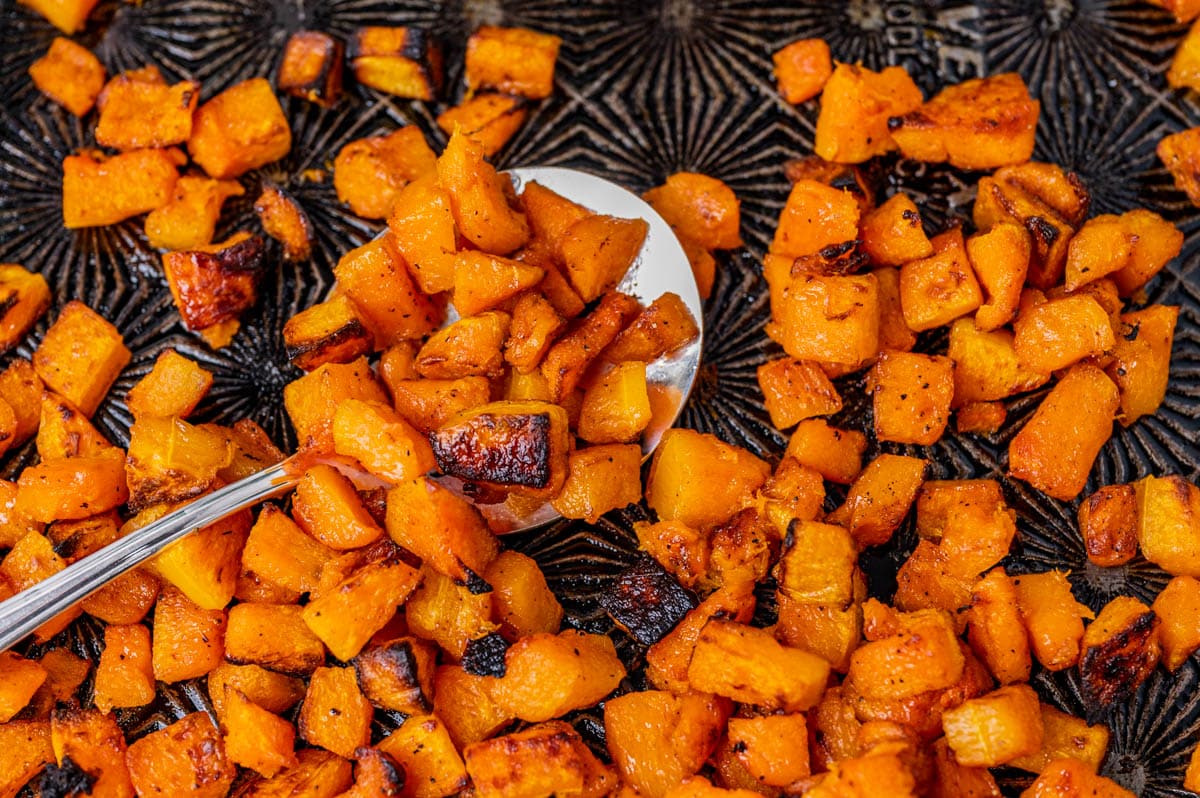
The final result should be tender and roasted butternut cubes with a slightly crispy and caramelized edges, can also add some fresh herbs or spices as you wish.
Some variations of this recipe that you can also try include adding diced onion or minced garlic for added flavor, or tossing the squash with a mixture of your favorite herbs and spices. You can also top the roasted squash with grated Parmesan cheese or chopped nuts for added texture and flavor.
Roasted butternut squash is delicious on salads, but also good with meat main dishes such as pork tenderloin or roast turkey.
How to Use Butternut Squash
Here are some of the best ways to use butternut squash:
- Pureeing: Peel and seed the squash, then cut it into cubes. Boil or steam until tender, then puree in a food processor or blender for a smooth and creamy puree that can be used as a base for soups, sauces, or dips.
- Mashed: Mashed butternut squash with maple syrup, butter, cream and parmesan.
- Soups: Dice the squash and sauté with onions, garlic, and spices. Then add chicken or vegetable broth and cook until tender to make a comforting and hearty soup. If the squash is already cooked, add it in the end and heat through.
- Gratin: Cut the squash into thin slices, layer them in a baking dish with cream, cheese, and breadcrumbs, then bake until golden brown. This is similar to potatoes au gratin.
- Stuffed: Cut the squash in half, scoop out the seeds, then stuff the hollowed-out squash with your favorite fillings like rice, meat, and vegetables, then bake until tender.
- Smoothies: Add small amount of cooked butternut squash to a blender with other ingredients for a delicious breakfast or snack. It adds a fabulous sweet flavor and creamy texture.
- Butternut Squash Pie: Almost as good as pumpkin pie.
Frequently Asked Questions
Is butternut squash a winter squash?
Yes, it is considered a winter squash because it is harvested in late fall. It has a hard, thick skin and can be stored for several months. Other examples are acorn and spaghetti squash.
Can I use butternut squash in place of sweet potatoes?
Yes. Butternut squash is lower in calories and carbs so is often used as a replacement for sweet potatoes.
Is butternut squash good with cinnamon?
Yes. Sprinkle ground cinnamon on top of baked butternut squash and drizzle with maple syrup. You can also sprinkle with brown sugar.
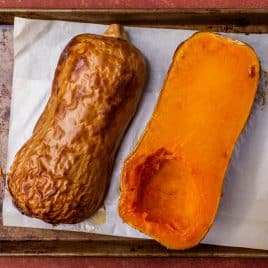

How to Cook Butternut Squash in the Oven
Butternut squash is a delicious and nutritious fall and winter vegetable that is versatile and easy to cook. Here's our step-by-step guide on how to cook butternut squash in the oven.
Servings 4
Prep Time 10 minutes
Cook Time 30 minutes
Ingredients
- 1-2 pound butternut squash
For roasting:
- 2 tablespoons olive oil
- 3/4 teaspoon salt
- 1/2 teaspoon black pepper
Instructions
To cook butternut squash halves:
- Preheat the oven to 400ºF. Line a baking pan with parchment paper.
- Cut the butternut squash in half lengthwise.
- Use a spoon to scoop out seeds. Throw away any seeds and pulp.
- Place the squash on the prepared pan, cut side down. Or, you can bake them cut side up, spreading with melted butter and sprinkling with salt and pepper before baking.
- Bake for 45-55 minutes. Test the thickest part of the squash to make sure it is done.
To make roasted butternut squash:
- Preheat your oven to 450°F.
- Cut the bottom and the stem off of the squash.
- Cut the butternut squash in half lengthwise, and scoop out the seeds and stringy pulp with a spoon. Discard the seeds and pulp.
- Peel the skin off the squash with a vegetable peeler or a sharp knife.
- Cut the squash into bite-sized cubes, about 1 inch in size.
- Toss the cubed squash with 1-2 tablespoons of olive oil, and season with salt and pepper to taste.
- Spread the squash out in a single layer on a greased baking sheet. (Dark baking sheets will help the squash brown more quickly.)
- Roast the squash in the preheated oven for 10 minutes, then stir. Roast for another 5 minutes and stir again. Then turn the oven to broil on low. Continue to cook the squash under the broiler, stirring every 2-3 minutes. This will help ensure it doesn't brown. If you don't care about it being crispy brown, just allow it to continue cooking at 450ºF instead of under the broiler.
- The squash is ready to eat when it is fork tender.
- Serve warm. Store leftovers in the fridge in an airtight container.
Notes
Refer to the article above for more tips and tricks.
The calories shown are based on the recipe serving 4 people, with 1 serving being ¼ of the squash. If you don’t add butter or oil, the calories and fat content will be lower. Since different brands of ingredients have different nutritional information, the calories shown are just an estimate. **We are not dietitians and recommend you seek a nutritionist for exact nutritional information. The information in the nutrition box are calculated through a program and there is room for error. If you need an accurate count, I recommend running the ingredients through your favorite nutrition calculator.**
Nutrition
Calories: 114kcal | Carbohydrates: 13g | Protein: 1g | Fat: 7g | Saturated Fat: 1g | Polyunsaturated Fat: 1g | Monounsaturated Fat: 5g | Sodium: 441mg | Potassium: 403mg | Fiber: 2g | Sugar: 2g | Vitamin A: 12056IU | Vitamin C: 24mg | Calcium: 56mg | Iron: 1mg
